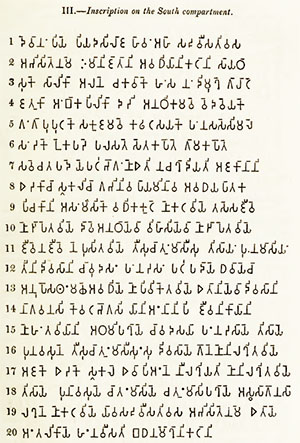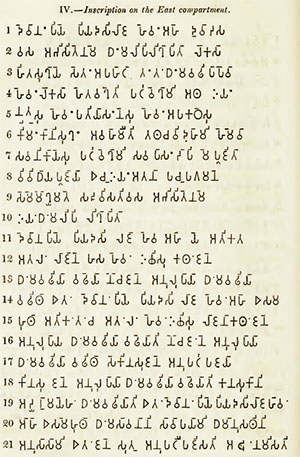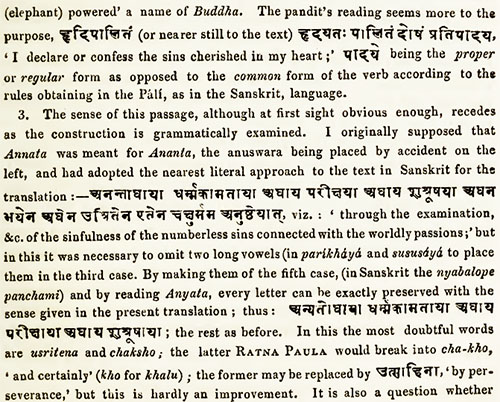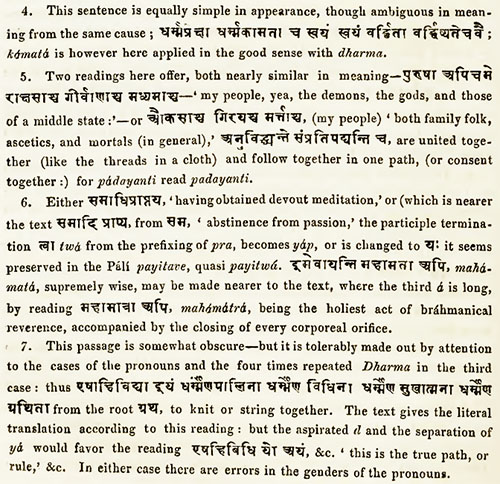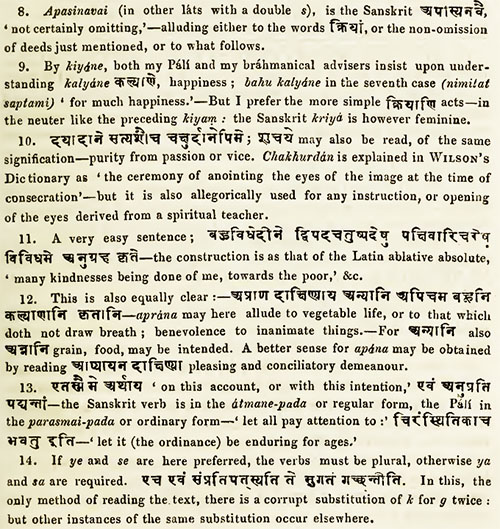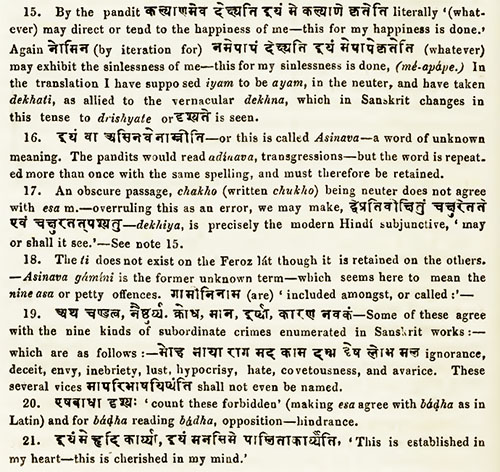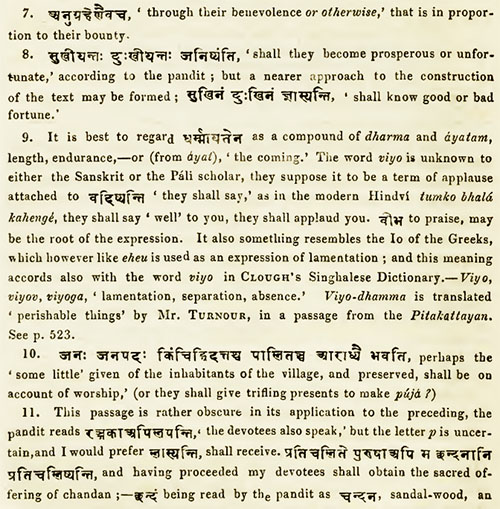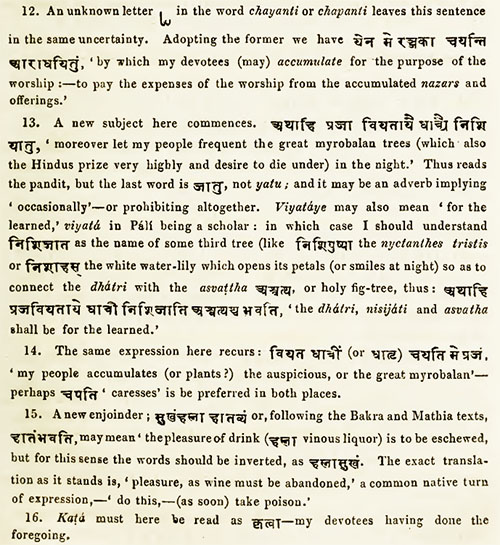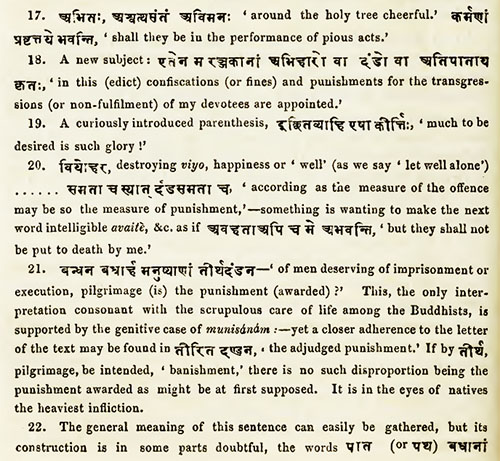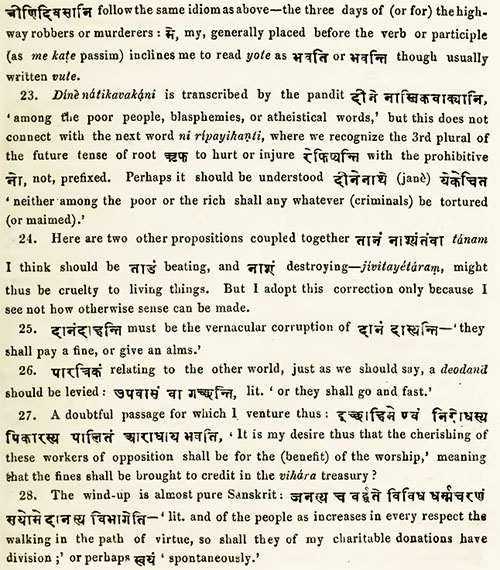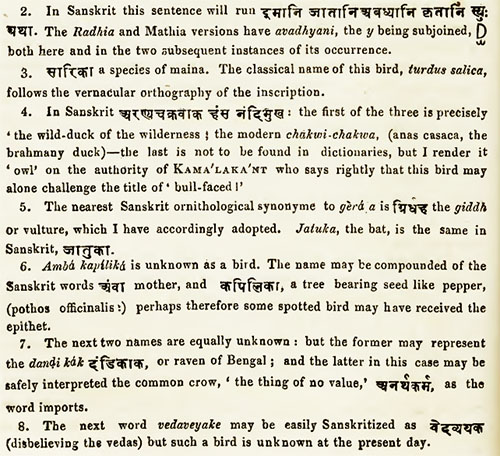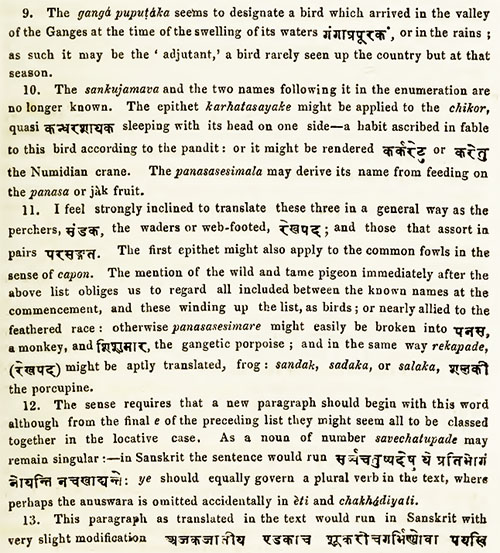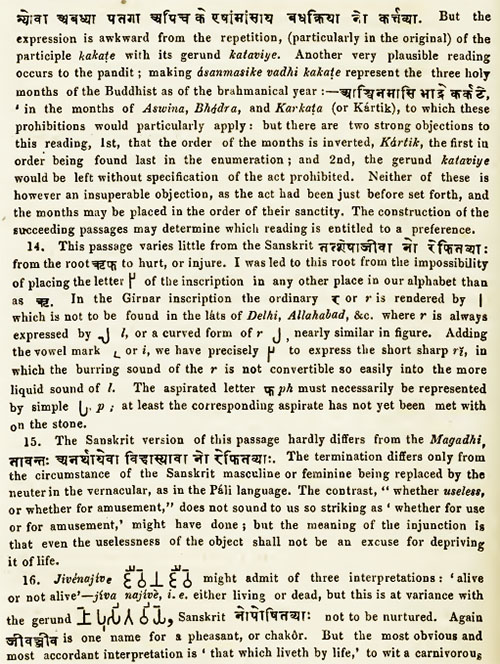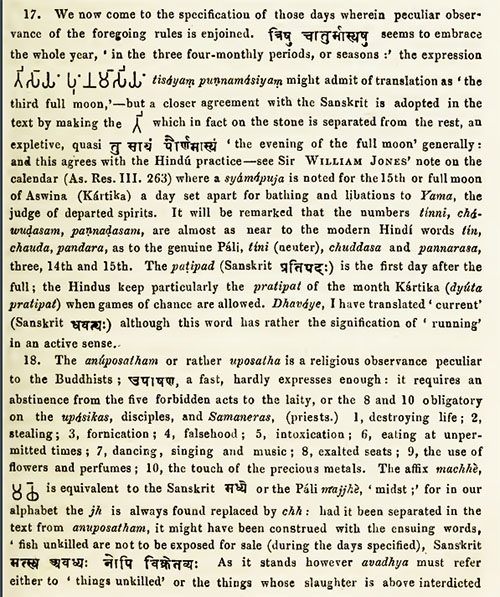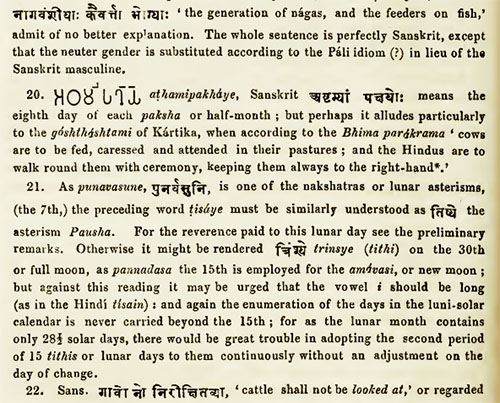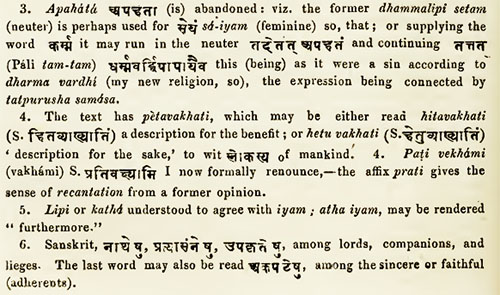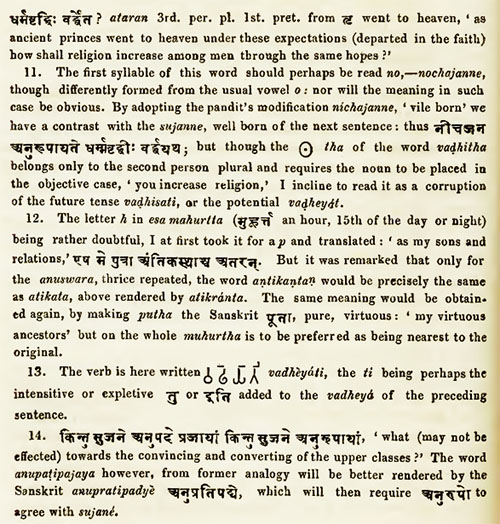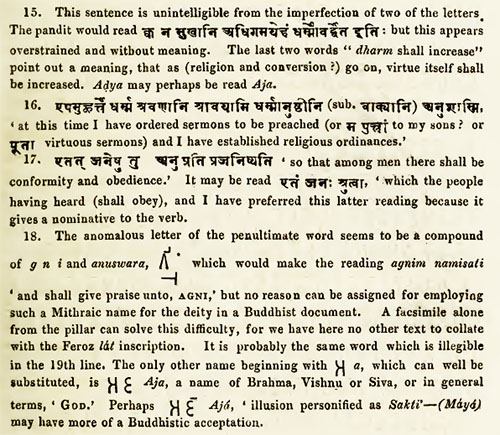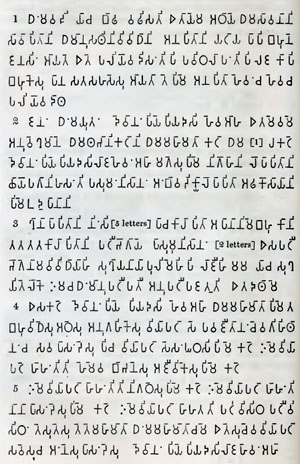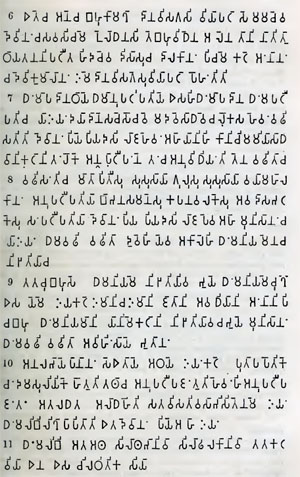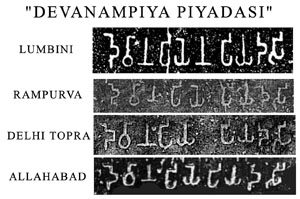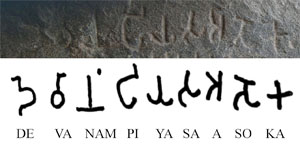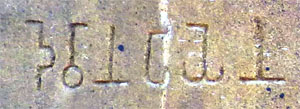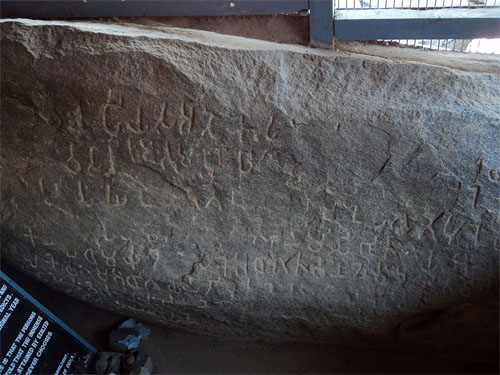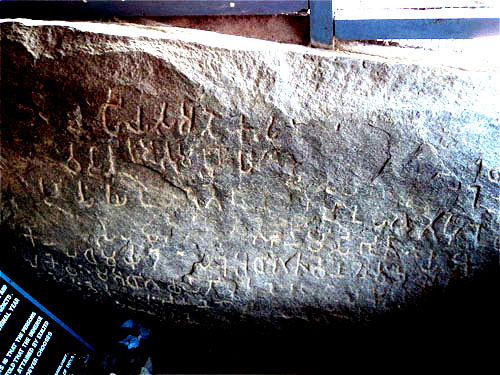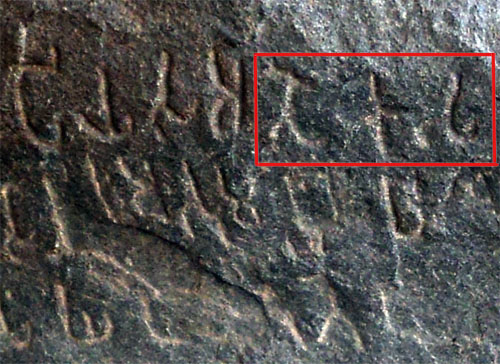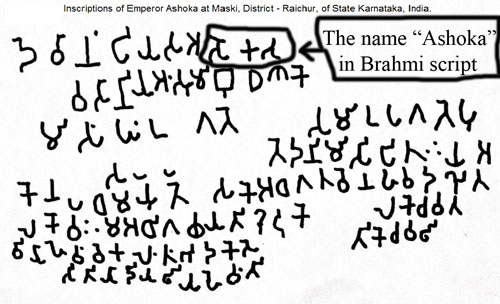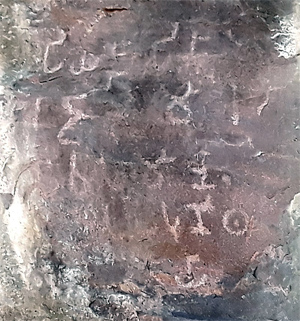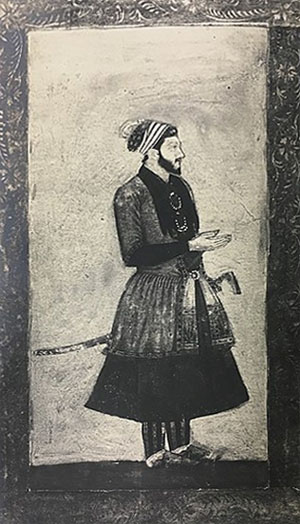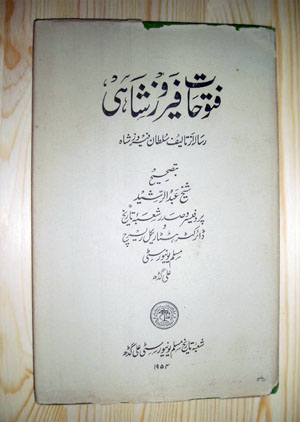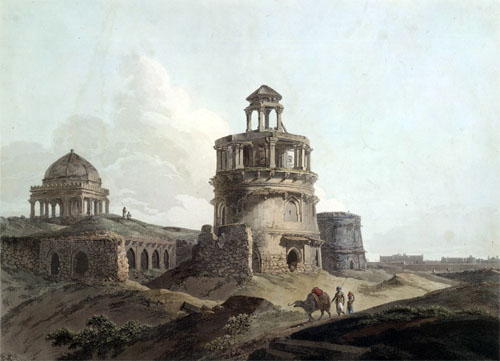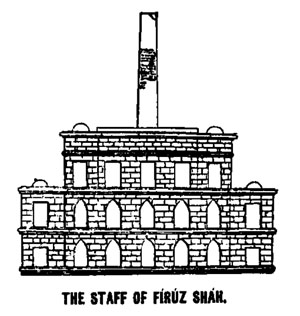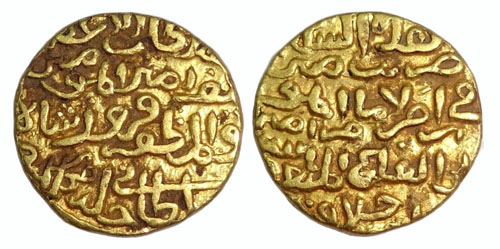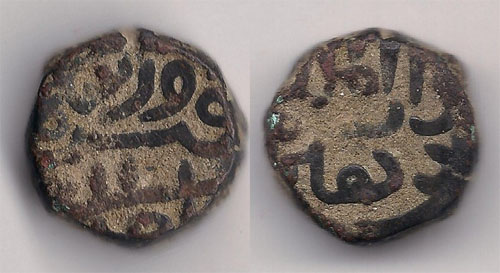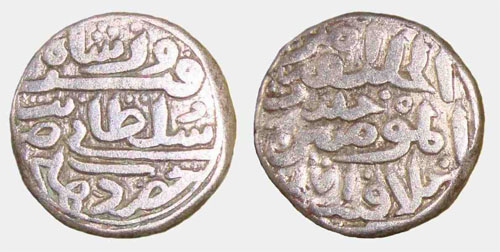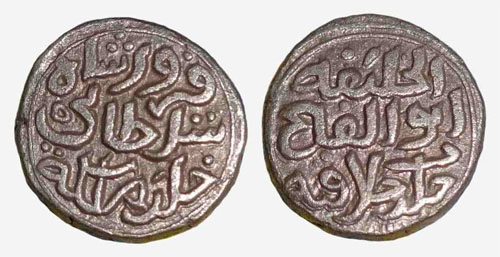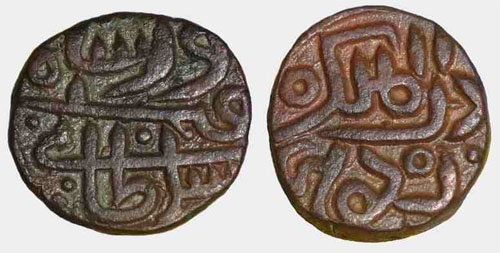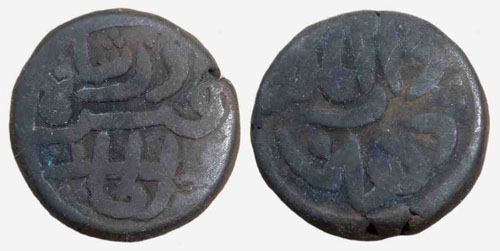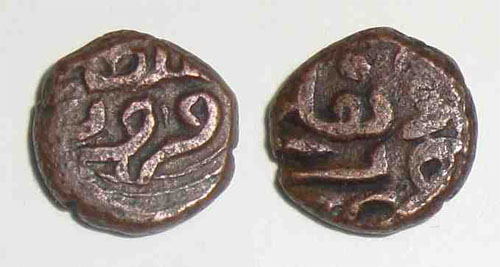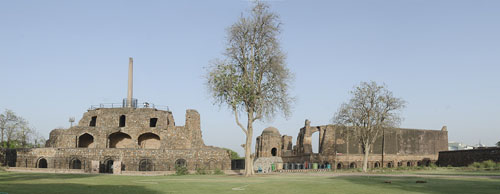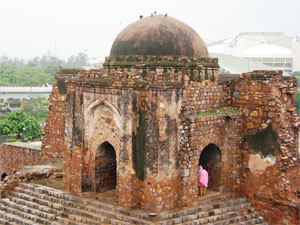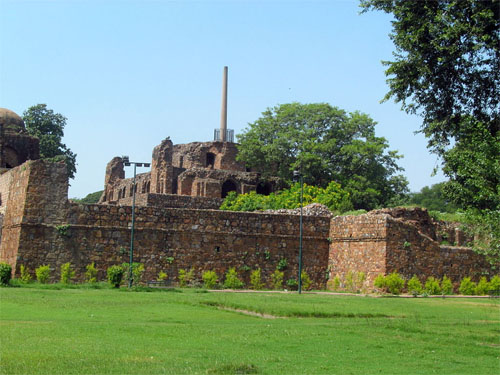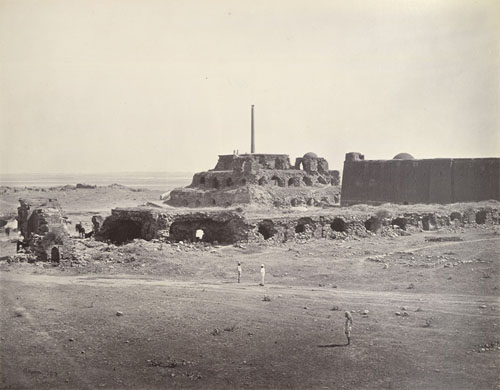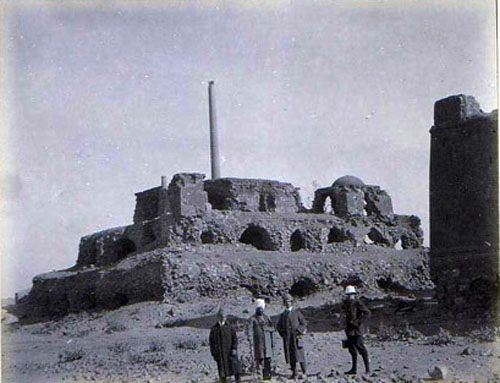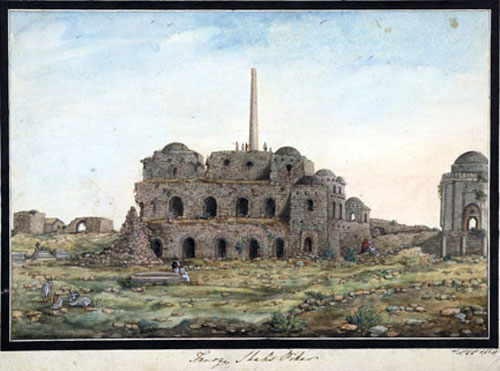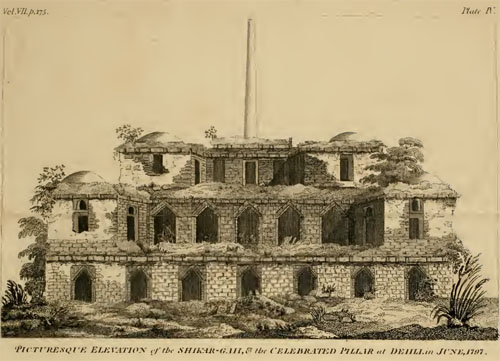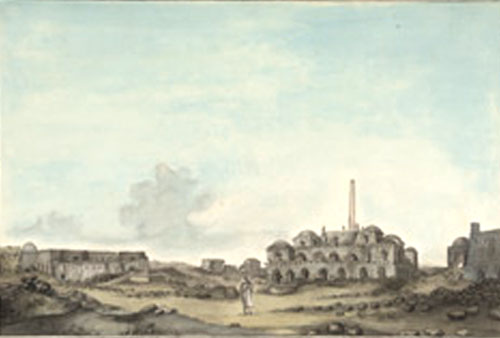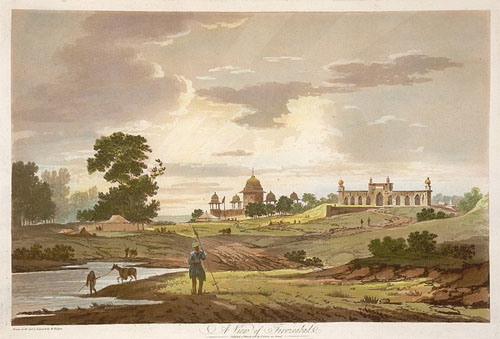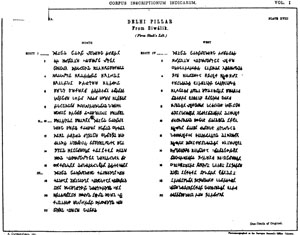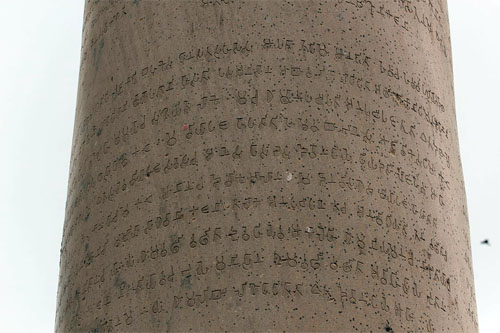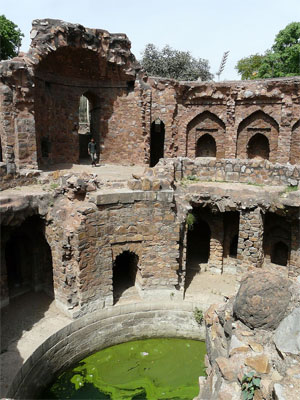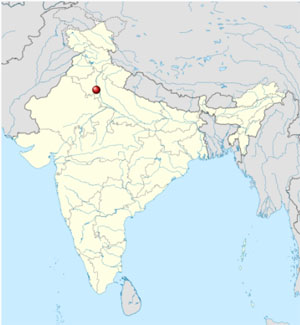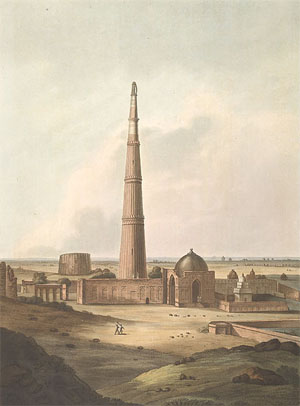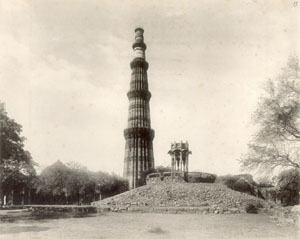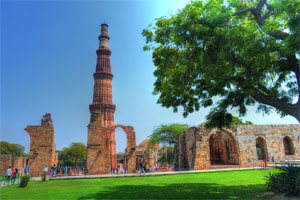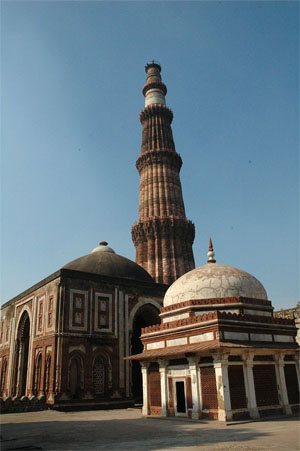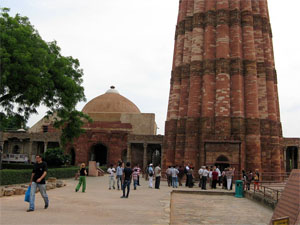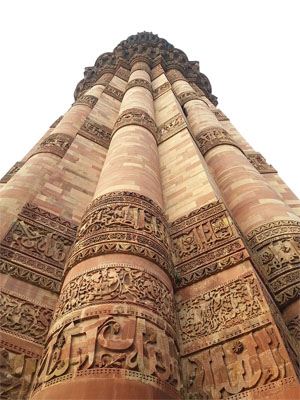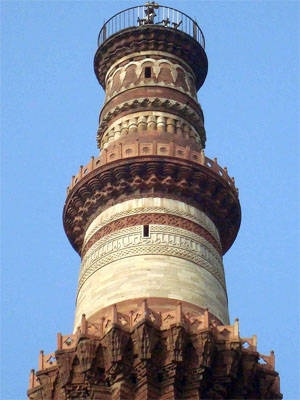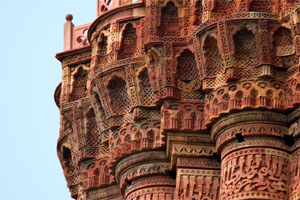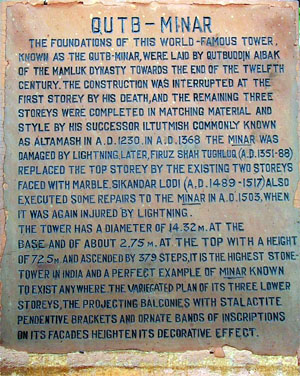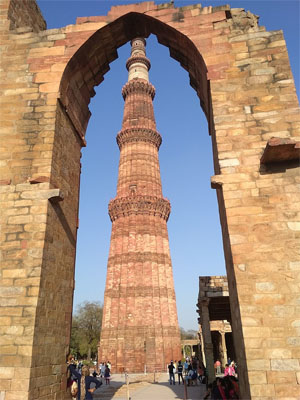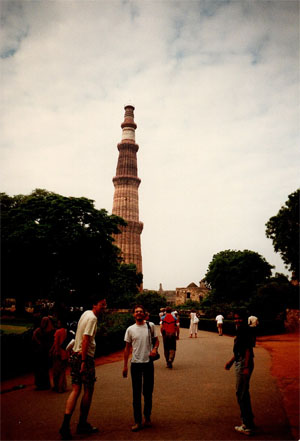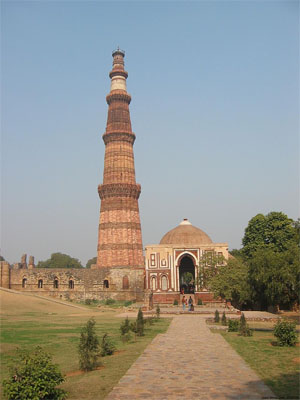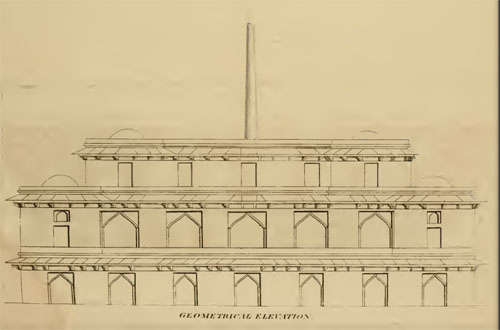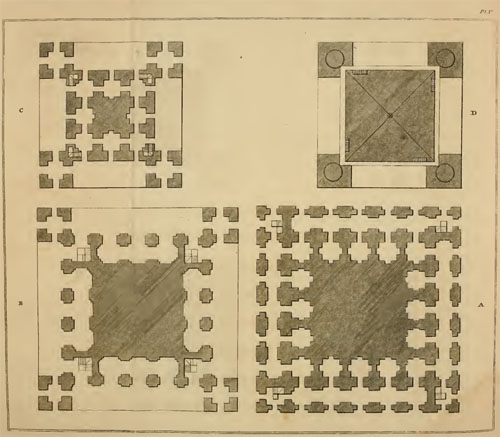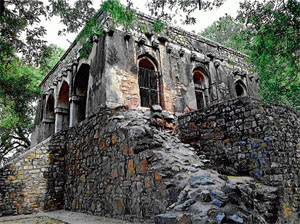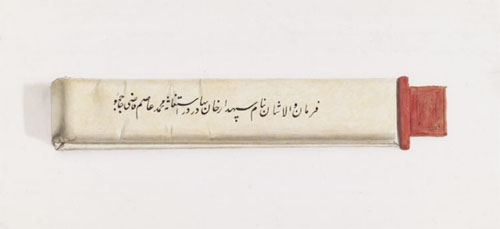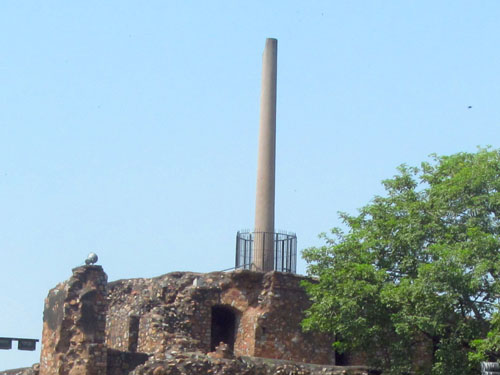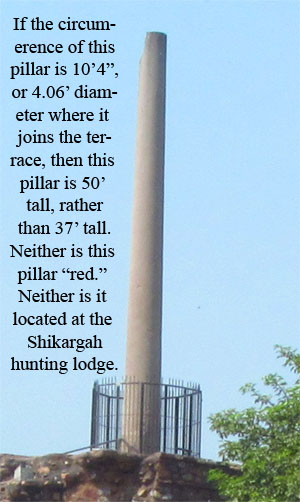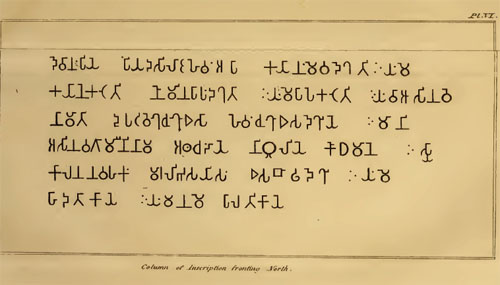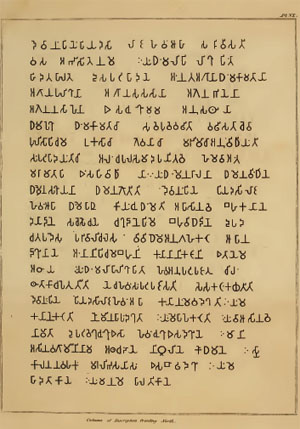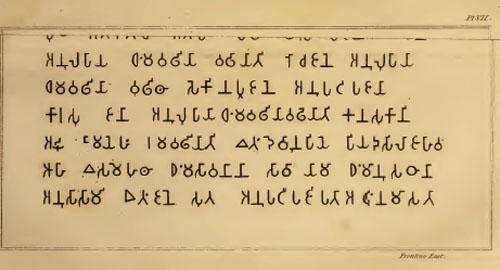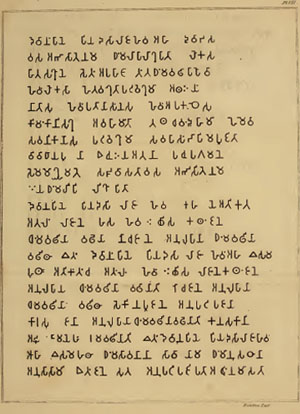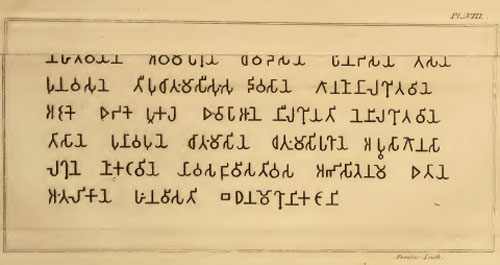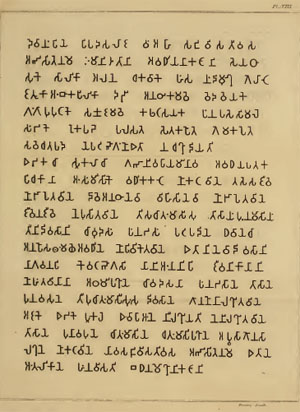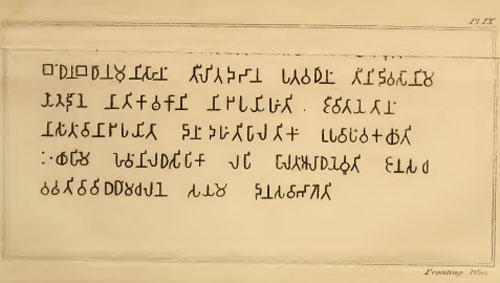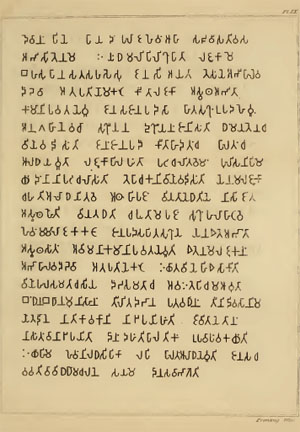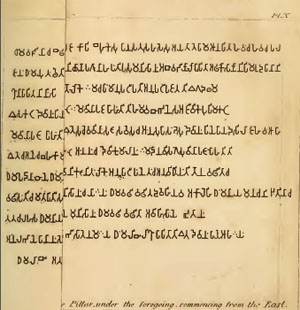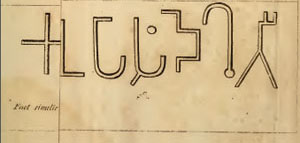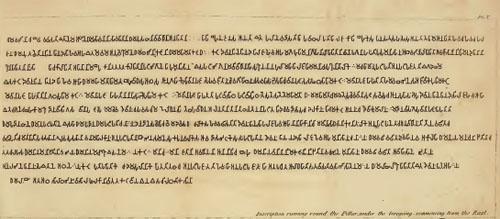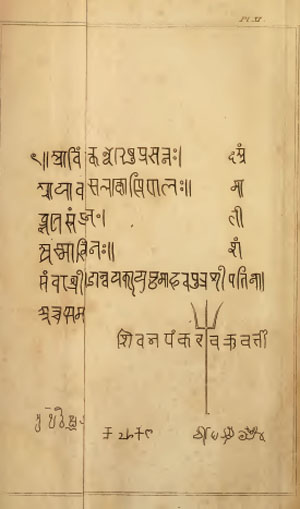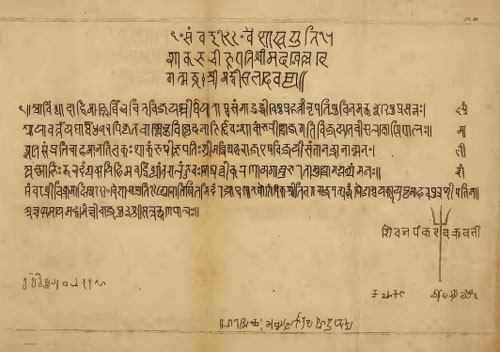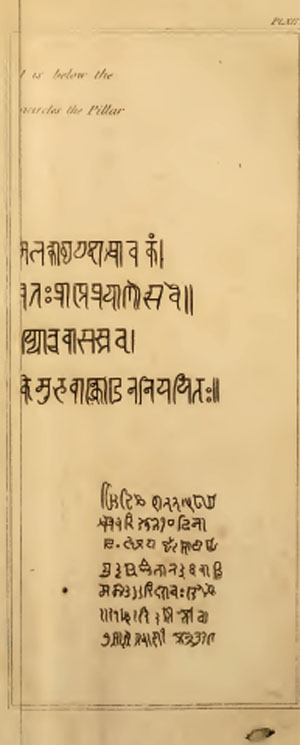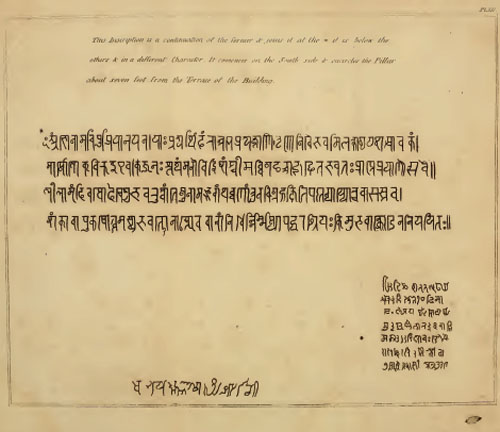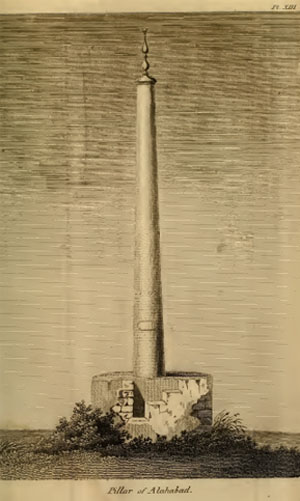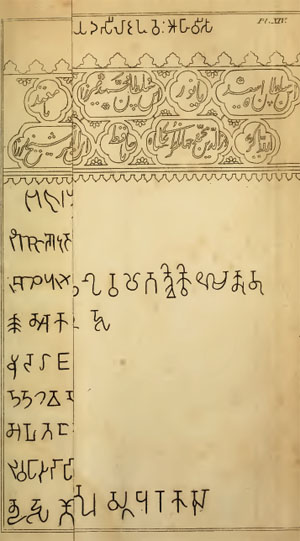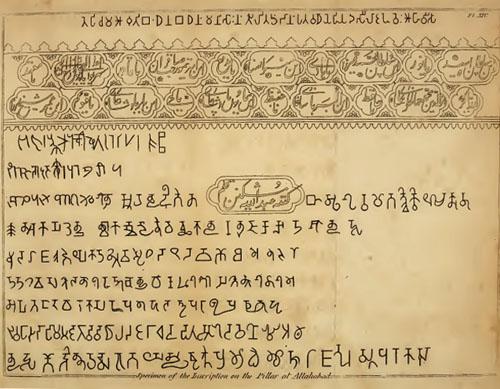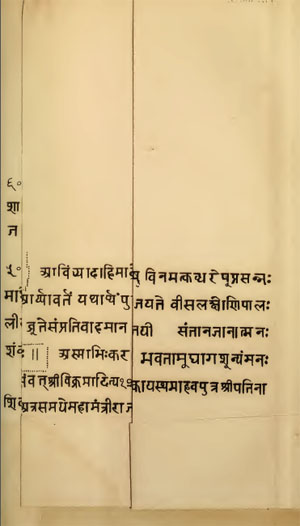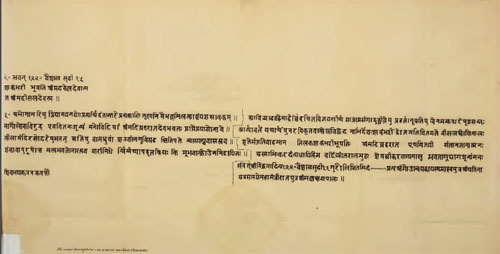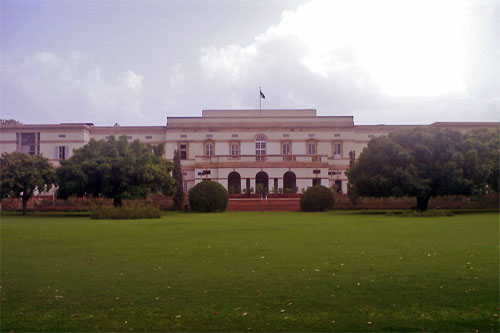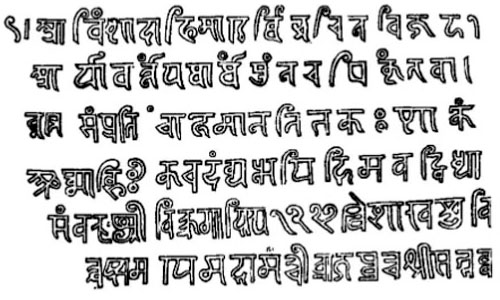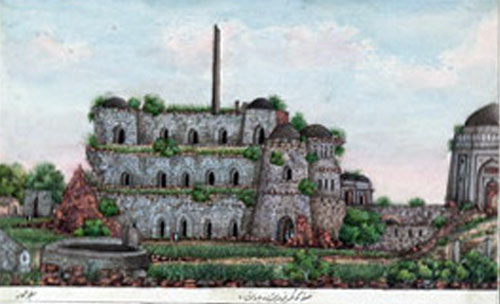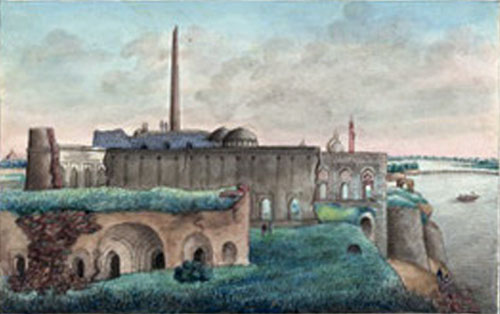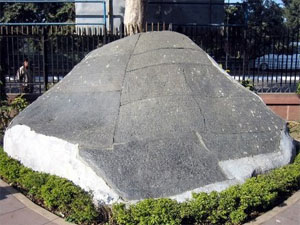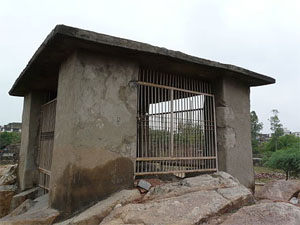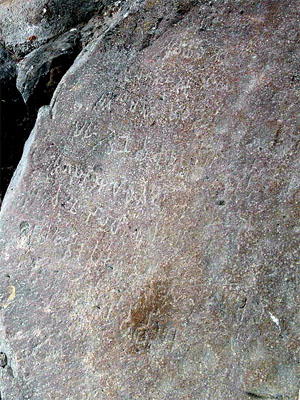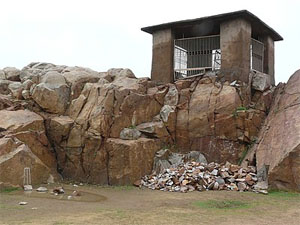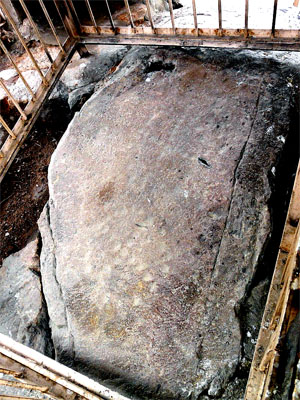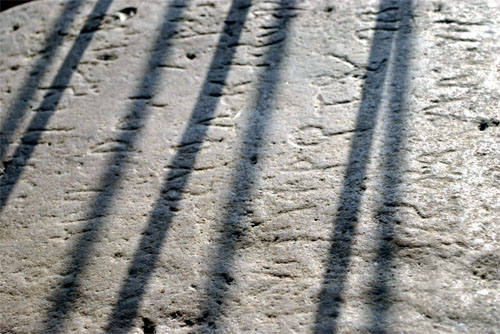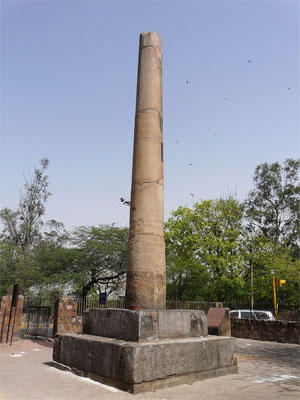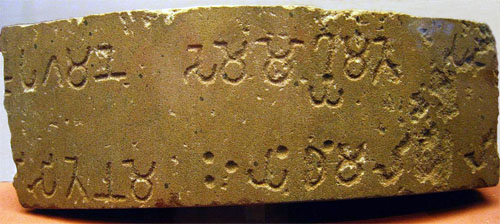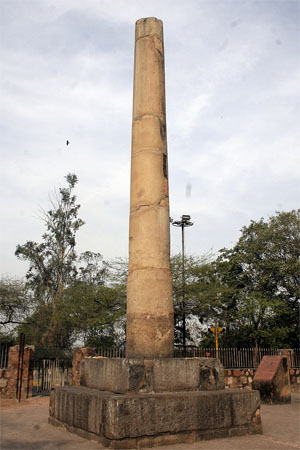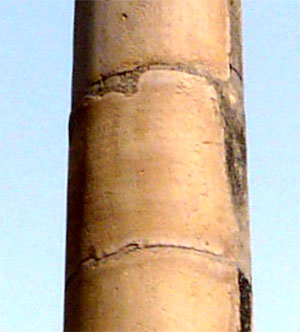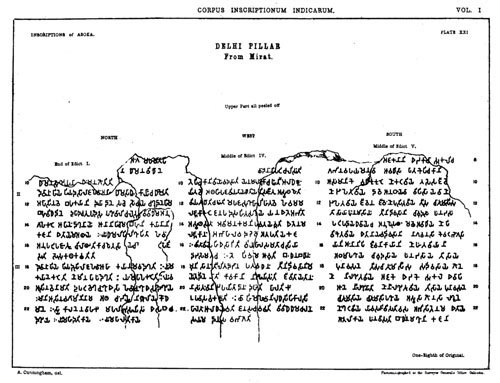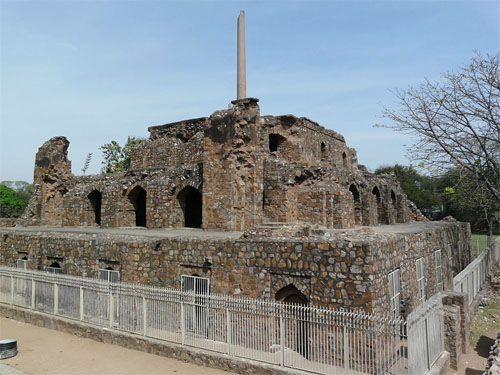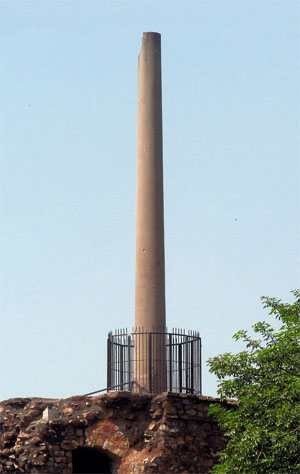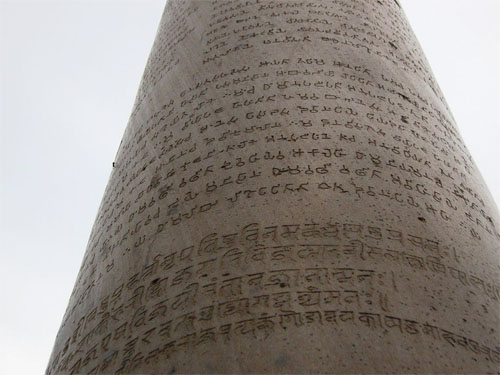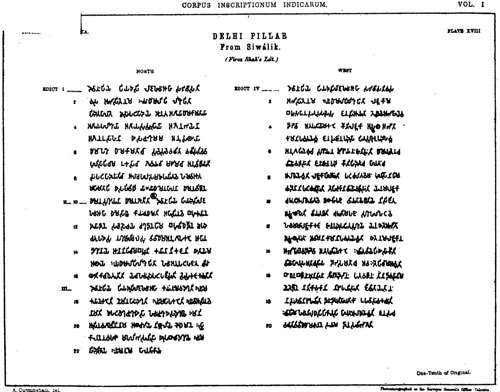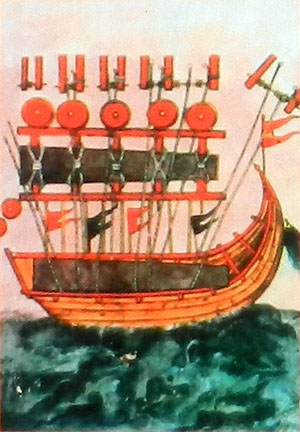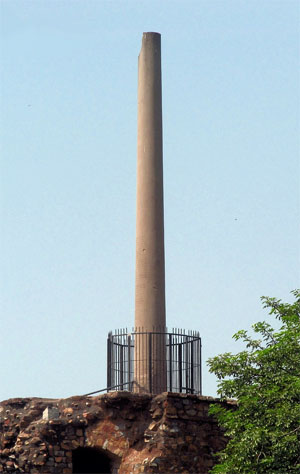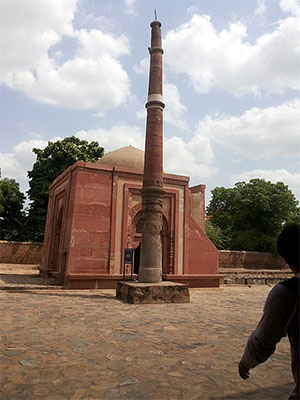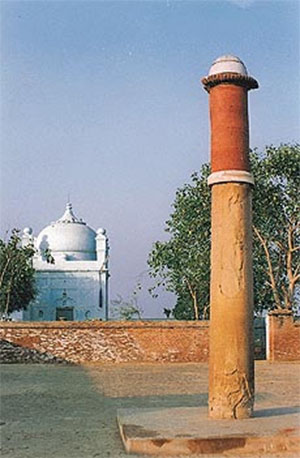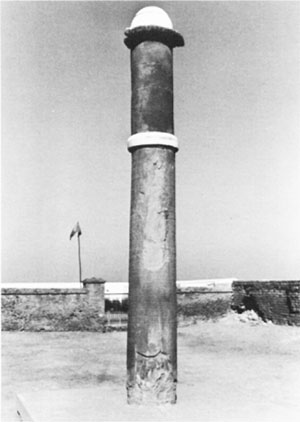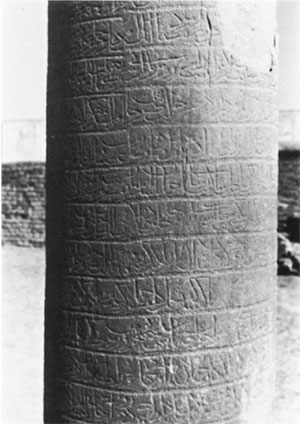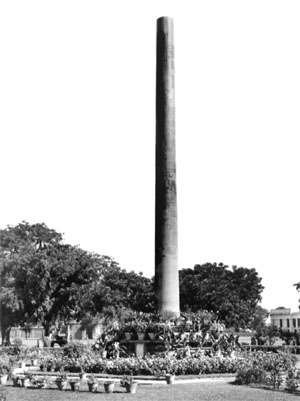VI.—Interpretation of the most ancient of the inscriptions on the pillar called the lat of Feroz Shah, near Delhi, and of the Allahabad, Radhia [Lauriya-Araraj (Radiah)] and Mattiah [Lauriya-Nandangarh (Mathia)] pillar, or lat, inscriptions which agree therewith.
by James Prinsep, Sec. As. Soc. &c.
The Journal of the Asiatic Society of Bengal
Vol. VI, Part II
July to December, 1837
All of the early Indian inscriptions in Mauryan Brahmi script need to be reexamined in detail in specialized studies intended to reveal what the texts actually do tell us, rather than to repeat what scholars have thought the texts should say.
-- Appendix C: On The Early Indian Inscriptions, Excerpt from Greek Buddha: Pyrrho's Encounter With Early Buddhism in Central Asia, by Christopher I. Beckwith
Unlike Kharosthi, which was always geographically limited and died out at a relatively early period, the Brahmi script appeared in the third century B.C. as a fully developed pan-Indian national script (sometimes used as a second script even within the proper territory of Kharosthi in the northwest) and continued to play this role throughout history, becoming the parent of all of the modern Indic scripts both within India and beyond. Thus, with the exceptions of the Indus script in the protohistoric period, of Kharosthi in the northwest in the ancient period, and of the Perso-Arabic and European scripts in the medieval and modern periods, respectively, the history of writing in India is virtually synonymous with the history of the Brahmi script and its derivatives.
Until the late nineteenth century, the script of the Asokan (non-Kharosthi) inscriptions and its immediate derivatives was referred to by various names such as "lath" or "Lat,"38 [This name arose from the occurrence of Asokan inscriptions on pillars known colloquially in northern India as lath (< Skt. yasti).] "Southern Asokan," "Indian Pali," "Mauryan," and so on. The application to it of the name Brahmi [sc. lipi], which stands at the head of the Buddhist and Jaina script lists, was first suggested by T[errien] de Lacouperie,39 ["Did Cyrus Introduce Writing into India?" Babylonian and Oriental Record 1, 1886-87, 58-64 (esp. 59-60). As noted by Falk (SAI 84, 106), Terrien de Lacouperie evidently got the references in question from the note of T. Choutze (pseudonym of Gabriel Deveria) in the Revue de l'Extreme-Orient 1, 1882, 158-9, though he does not mention him.] who noted that in the Chinese Buddhist encyclopedia Fa yuan chu lin the scripts whose names corresponded to the Brahmi and Kharosthi of the Lalitavistara are described as written from left to right and from right to left, respectively. He therefore suggested that the name Brahmi should refer to the left-to-right "Indo-Pali" script of the Asokan pillar inscriptions, and Kharosthi to the right-to-left "Bactro-Pali" script of the rock inscriptions from the northwest. Lacouperie's suggestion was adopted by his contemporaries, most significantly by Buhler40 [The expression "Brahma alphabet" used by Buhler in OIBA has, however, been supplanted in modern usage by "Brahmi" [lipi].] in his influential works, and thereby became the accepted term. While the name Brahmi for the ancient Indian national script is no doubt in a general sense correct, it should be kept in mind that we do not really know precisely what form or derivative of the script the authors of the early script lists were referring to as "Brahmi," nor whether this term was actually applied to the script used in the time of Asoka.41 [On this point, see the warnings in 1C 11.667 and OBS 99.] The name Brahmi is thus used loosely, as a matter of convenience, by modern scholars to refer to the Asokan script and to its varieties and earlier derivatives (distinguished by regional or dynastic terms such as "early southern Brahmi" or "eastern Gupta Brahmi") until about the end of the Gupta period in the sixth century A.D. After this time, the scripts have for the most part differentiated into distinct regional and local varieties, and are conceived as separate scripts denoted by descriptive or, more commonly, geographical terms (e.g., Siddhamatrka [post-Gupta northern script] or proto-Kannada). The terminology for the various premodern Brahmi-derived scripts is, however, largely unstandardized and typically made up ad hoc, due mainly to the lack of attested indigenous terms for many of them....
The origin of the Brahmi script is one of the most problematic and controversial problems in Indian epigraphy ...
Recently several writers have put forth theories to the effect that Brahmi was purposefully invented ex nihilo ["creation out of nothing"] in or around the time of Asoka. S. R. Goyal, for example, 55 ["Brahmi—An Invention of the Early Mauryan Period," in OBS 1-53.] argued that the phonetically logical structure, primary geometric forms, and geographical uniformity of early Brahml show that it was "an invention of the grammarians" (10) of the time of Asoka. Similar arguments were presented by T. P. Verma, who proposed an origin in Buddhist circles.56 [The Palaeography of Brahmi Script in North India, 8, and "Fresh Light on the Origin of Brahmi Alphabet," JOI 13, 1964, 360-71 (esp. 367).] ...
The strongest point in favor of the invention theory is the stiffly symmetrical, geometric appearance of Asokan Brahmi, which does indeed give the impression of an arbitrarily created script....
[T]he discovery ... of six Mauryan inscriptions in Aramaic strongly supports the hypothesis of an Aramaic connection.
However, a possible objection to the derivation of Brahmi from Aramaic86 [As noted by Senart, JA, ser. 7, vol. 13, 1879, 534.] is that, since it has been established with virtual certainty that the Kharosthi script is derived from Aramaic, it is hard to see why another, very different, Indic script would have developed from the same prototype in a contiguous region. If the hypothesis of the invention of Brahmi under Asoka's sponsorship is correct, this re-creation may be attributed to the emperor's desire to invent a distinct imperial script, perhaps under the inspiration of Old Persian cuneiform, which would be suited to the promulgation of edicts in written form.87 [As proposed by, among others, Falk (SAI 338-9), although he sees Kharosthi itself, rather than Aramaic, as the principal prototype of Brahmi.] But it must be admitted that there is no direct statement to this effect in the edicts themselves....
The first publication of an old Indian inscription was by the "Sanscrit-mad"3 [So called by H. Colebrooke; see Windisch, Geschichte der Sanskrit-Philologie, 23 n. 1.] (Sir) Charles Wilkins (1749-1836),4 [On Wilkins, see E. H. Johnston, "Charles Wilkins," in Mohammad Shafi, ed., Woolner Commemoration Volume, Mehar Chand Lachhman Das Sanskrit and Prakrit Series, vol. 8 (Lahore: Mehar Chand Lachhman Das, 1940), 124-32; and Mary Lloyd, "Sir Charles Wilkins, 1749-1836," in Indian Office Library and Records: Report for the Year 1978 (London: Foreign and Commonwealth Office, 1979), 8-39. The dates for Wilkins' life given by Windisch (Geschichte der Sanskrit-Philologie, 23), 1750-1833, are evidently incorrect.] one of the greatest of the pioneer Indologists, in his article "A Royal Grant of Land, Engraved on a Copper Plate, Bearing Date Twenty-three Years Before Christ; and Discovered Among the Ruins at Mongueer. Translated from the Original Sanscrit, by Charles Wilkins, Esq. in the Year 1781,"5 [According to Lloyd, op. cit., this article "had been first published in Calcutta in 1781, printed by Wilkins" (21 n. 27). The paper was presented to the Asiatic Society on July 7, 1785; see Sibadas Chaudhuri, ed., Proceedings of the Asiatic Society. Vol. 1: 1784—1800 (Calcutta: The Asiatic Society, 1980), 57.] in Asiatick Researches (AR) 1 (1788), 123-30.6 [The inscription in question is the Mungir (Monghyr) copper plate of Devapaladeva (IA 21, 253-58).] This was followed by "An Inscription on a Pillar near Buddal" in AR 1, 131-41.7 [The Badal pillar inscription of the time of Narayanapala (SI II, 87-91). The paper was presented to the society on July 14, 1785 (Chaudhuri, Proceedings, 58).] These articles, like most of the earliest epigraphic papers published in AR, consist only of translations, without the text of the inscription and with little or no introductory matter. Both of Wilkins' inscriptions date from the Pala period, about the ninth century A.D.; although decidedly archaic, the script of these two epigraphs could be read by comparisons to the modern and archaic forms of Devanagari and Bengali scripts known in Wilkins' time,8 [Sircar refers to "the application of his knowledge of the late medieval Bengali and Nagari scripts gradually acquired from a study of manuscripts" (EINES 81).] and he was thus able to produce interpretations of the inscriptions which were substantially accurate, though by no means correct in all points. His estimate of the age of these inscriptions, however, was off by nearly a millennium, because he interpreted the date samvat 33 of the Mungir inscription as a year of the Vikrama era equivalent to 23 B.C., whereas in fact it is a regnal year of Devapaladeva, who ruled in the first half of the ninth century.
An even more remarkable achievement by Wilkins was his translation, published as a letter in AR 1, 279-83, of the record now known as the Nagarjuni hill cave inscription of the early Maukhari king Anantavarman.9 [Presented March 17, 1785 (Chaudhuri, Proceedings, 47).] While his comment that the script is "very materially different from that we find in inscriptions of eighteen hundred years ago" is due to his incorrect dating of the Mungir plate alluded to earlier, he was nonetheless correct that "the character is undoubtedly the most ancient of any that have hitherto come under my inspection." (Anantavarman is now known to have ruled sometime in the sixth century A.D.) It is truly remarkable that Wilkins was somehow able to read the late Brahmi of this period, which, unlike the scripts of three centuries later, is very different from modern scripts both in its general form and in many of its specific characters. It is thus not entirely clear how, beyond pure perseverance and genius, Wilkins managed to read this inscription, but presumably he did this by working back from the script of the Pala period which he had already mastered.10 [The precise order in which Wilkins translated his first three inss. is not certain, but it is clear that he worked on the Mungir ins. first, in 1781, and that the Nagarjuni and Badal inss. followed in the period between 1781 and his presentation of all three inss. to the society in 1785 (see Kejariwal, The Asiatic Society, 43-4).] In any case, his translation, while once again not always correct, proves beyond question that he could read the late Brahmi, or early Siddhamatrka, script of the sixth century. We may compare, for example, his translation of the first verse:When the foot of the Goddess was, with its tinkling ornaments, planted upon the head of Maheeshasoor, all the bloom of the new-blown flower of the fountain was dispersed, with disgrace, by its superior beauty. May that foot, radiant with a fringe of refulgent beams issuing from its pure bright nails, endue you with a steady and an unexampled devotion, offered up with fruits, and shew you the way to dignity and wealth! (282)
with the standard rendition by J. F. Fleet in CII 3, 227:May the foot of (the goddess) Devi, fringed with the rays of (its) pure nails point out the way to fortune, endowing with a (suitable) reward your state of supplication which is such as befits the expression of firm devotion;—(that foot) which, surpassing in radiance all the beauty of a full-blown waterlily, was disdainfully placed, with its tinkling anklet, on the head of the demon Mahishasura!11 [The text, in Fleet's reading (227), is unnidrasya saroruhasya sakalam aksipya sobham ruca savajnam Mahisasurasya sirasi nyastah kvanannupurah / devya vah sthirabhaktivadasadrsim yunjan phalenarthitam disyad acchanakhansujalajatilah padah padam sampadam //.]
Here Wilkins has clearly read and construed the verse correctly. Elsewhere in this and other articles his translations are less accurate, and not infrequently he errs in dividing words and compounds, in construing the syntax of complex verses, or in rendering idiomatic expressions.12 [E.g., Wilkins translates the beginning of the third verse of the Nagarjuni inscription as "honor was achieved from the deed of death near the uprising ocean," evidently reading udirna-maharnavopa- marana-vyapara-labdham yasah; the correct reading and translation (by Fleet) are udirnamaharnav- opama-rana-vyapara-labdham yasah, "the renown that he had acquired in the occupation of war resembling . . . the great swollen ocean."] But despite such inevitable imperfections, Wilkins' treatment of these difficult documents is nothing short of remarkable, given the almost nonexistent resources available at the time.13 [The same may be said of Wilkins' subsequent translation (AR 2, 1790, 167-9) of two further Maukhari inss. from the Barabar and Nagarjuni caves (= CII 3, 221-6).]...
After the slow but steady progress of the first three decades of the nineteenth century, the study of Indian inscriptions erupted in a blaze of glory in the middle of the 1830s. The "Glanzjahre"23 [Thus appropriately called by Windisch, Geschichte der Sanskrit-Philologie, 98.] of 1834 to 1838 were largely, though by no means exclusively, due to the remarkable efforts and insights of James Prinsep (1799-1840), who came to India in 1819 as assistant to the assay master of the Calcutta Mint and remained until 1838, when he returned to England for reasons of health. During this period Prinsep made a long series of discoveries in the fields of epigraphy and numismatics24 [For a collection of his essays on these subjects, together with extensive supplementary notes by Edward Thomas, see Essays on Indian Antiquities, Historic, Numismatic, and Palaeographic, of the Late James Prinsep.] as well as in the natural sciences and technical fields. But he is best known for his breakthroughs in the decipherment of the Brahmi and Kharosthi scripts.
Although many Sanskrit inscriptions had been published since the time of the pioneers Wilkins and Colebrooke, and although some of the later scripts derived from Brahmi had been successfully read, inscriptions of the Gupta period and earlier remained incomprehensible when Prinsep began his epigraphic researches in the early 1830s; this, despite Wilkins' having already read, four decades earlier, inscriptions of the sixth century. Renewed progress in the decipherment of early Brahmi25 [Referred to in early works by various names, most commonly "lath [i.e., lat] character" and "Indian Pali".] began in 1834 with T. S. Burt's procurement of reliable facsimiles of the inscriptions on the Allahabad pillar,26 [See JASB 3, 105-13.] including the Asokan pillar edicts and the "Queen's Edict" as well as the inscription of Samudragupta. Prinsep's "Notes on Inscription No. 1 [the Asokan inscriptions] of the Allahabad Column"27 [JASB 3, 1834, 114-8.] broke the first ground in the reading of Mauryan Brahmi script. In this brief paper Prinsep displayed a combination of intuition and methodical thought which would do any modern decipherer proud. He expressed, first of all, doubts as to "whether the language this character . . . expresses is Sanscrit" (116), noting especially the "rare occurrence of double letters" (i.e., conjunct consonants). Although in subsequent articles between this one and his final breakthrough three years later Prinsep seems to have changed his mind and considered that the unknown language was Sanskrit,28 [See, e.g., JASB 3, 487.] in the end his first intuition that the inscriptions were not in Sanskrit proved to be correct. Given what little was known at the time of the history of the Indic languages, this was a remarkable insight, since it would have seemed almost automatic to assume that the language of such clearly ancient inscriptions would be Sanskrit.
Equally impressive was Prinsep's arrangement, presented in plate V of JASB 3, of the unknown alphabet, wherein he gave each of the consonantal characters, whose phonetic values were still entirely unknown, with its "five principal inflections" (117), that is, the vowel diacritics. Not only is this table almost perfectly correct in its arrangement, but the phonetic value of the vowels is correctly identified in four out of five cases (plus anusvara); only the vowel sign for i was incorrectly interpreted as o. Moreover, Prinsep also provided statistical counts for each principal consonantal character and its vocalic "inflections" and noted "other forms occurring."...As one mode of aiding the investigation of the powers of the unknown alphabet, supposing the language expressed to be Sanscrit, I had the letters in a page of the Bhatti Kavya classified and counted, to compare with the enumeration in Plate VI. They were as follows:
I also made the same classification of one page of the Feroz lath inscription, which I found to agree pretty well with the table prepared from that of Allahabad. There is one marked difference, which may be due perhaps to the copyist: —I allude to the separation of the words in the former, which does not appear to be the case in Lieut. Burt's transcript. It would require an accurate acquaintance with many of the learned languages of the East, as well as perfect leisure and abstraction from other pursuits, to engage upon the recovery of this lost language; but when its simplicity of vocables is compared with the difficulties of the Persepolitan, or cuneiform character, lately deciphered by Grotefend and St. Martin, or the more abstruse hieroglyphics of Egypt attempted by Young and CHAMPOLLION, it seems almost a stigma on the learned of our own country that this should have remained so long an enigma to scholars; and the object of the present notice is to invite fresh attention to the subject, lest the indefatigable students of Bonn or Berlin should run away with the honor of first making it known to the learned world.
-- II.—Note on Inscription No. 1 of the Allahabad Column, by James Prinsep, Sec. &c., P. 114, The Journal of the Asiatic Society of Bengal, Vol. III, Jan-Dec, 1834
Prinsep also provided a statistical count of the letters appearing on a page of a Sanskrit text (the Bhattikavya) for purposes of "aiding the investigation of the powers of the unknown alphabet" (118). Although Prinsep's final decipherment was ultimately to rely on paleographic [the study of ancient or antiquated writings and inscriptions] and contextual rather than statistical methods (cf. Hoernle, Centenary Review, 60), it is still no less a tribute to Prinsep's genius that he should have thought to apply such modern techniques to his problem.
-- Indian Epigraphy: A Guide to the Study of Inscriptions in Sanskrit, Prakrit, and the Other Indo-Aryan Languages, by Richard Salomon
Contextual Inquiry is an ethnographic research method that helps to understand what people do and why they do it.... Contextual Inquiry relies on three main principles: focus, context, and partnership. Researchers establish a focus for the information they want to learn and as a filter for subsequent actions and activities. The focus helps identify the context: the specific environment to be studied. This may be an office, a home, or even a place as specific as an airplane or a coffee shop. The focus also directs selection of participants for research, and it is with these participants that the researchers will try to form a partnership. This partnership is characterized by qualities of apprenticeship—the researcher is an apprentice, hoping to learn as much as possible from the master. This education occurs by watching real work and by probing with questions.
-- Contextual Inquiry: What is it?, by Wicked Problems Worth Solving, wickedproblems.com
I now proceed to lay before the Society the results of my application of the alphabet, developed by the simple records of Bhilsa, to the celebrated inscription on Feroz's column, of which facsimiles have been in the Society's possession since its very foundation, without any successful attempt having been made to decipher them. This is the less to be wondered at when we find that 500 years before, on the re-erection of the pillar, perhaps for the second or third time, by the emperor Feroz [r. 1351–1388)], the unknown characters were just as much a mystery to the learned as they have proved at a later period — "Round it" says the author of the Haftaklim, "have been engraved literal characters which the most intelligent of all religions have been unable to explain. Report says, this pillar is a monument of renown to the rajas or Hindu princes, and that Feroz Shah set it up within his hunting place: but on this head there are various traditions which it would be tedious to relate."
For a full discussion of the very curious subject of Kang-diz, see Reinaud's 'Introduction to Abulfeda,' pp. ccxx. to ccxxiv. Reinaud himself is inclined to compare the term Kang with the old Chinese name of Kang-kui for Sogdiana but it is a sufficient answer to this to remark that Sughd was the first and the principal Perso-Aryan settlement, whereas nothing can be clearer from the Bundehesh and universal Zoroastrian tradition than that Kang-diz was beyond the Perso-Aryan world to the eastward. Kang-diz is everywhere connected in the Bundehesh 1stly, with the mountains of Shida or Bum, of doubtful orthography, but certainly representing the Tsung-ling of the Chinese; and 2ndly, with the river Shed which is of course the Shida of the Mongols, Sida of the Thibetans, and Sita of the Brahmans, running eastward from Meru, and identical with the river system of Yarkend and Kashghar. Compare the following passages "The Shed-rud where Pashutan (son of Gushtasp) is in Mogulistan." "The river where Pashutan is (i.e., the Shed-rud) is in Kang-diz." "Pashutan called Chitro-mino, is in Kang-diz." "Kang-diz is to the east." "Mount Sejda contains Kang-diz," &c. 'Zend Avesta,' tome ii. pp. 364, 391, 393, 409, and 410. I long ago suggested that Kang was a Pehlevi word, signifying "Heaven," and answering to the Sanscrit [x] ('Journ. Royal As. Soc.,' vol. x. pp. 146 and 321), and perhaps this is after all the most reasonable explanation of the term; but it has sometimes occurred to me that as Biruni evidently considered Kang to be a proper name translating Kang-diz as he did by "Kang's Castle " (see Reinaud, loc. cit.), it may possibly be a relic of the old name of Kanishka, or Kanika, which in the Arabic character is undistinguishable from the other title [x]. There are some grounds for supposing that Kanika (Kanerkes of the coins) derived his origin from Central Asia, and himself led the invading Yue-chi from Yarkend and Tashkurghan down the Chitral Valley to the conquest of Northern India. At any rate he held the Upper Oxus and Little Thibet, whilst reigning over Peshawer and the Punjab, and I cannot help therefore referring to a city of his foundation the curious notice which is preserved by Mirza Hyder in his account of Kashghar and Yarkend in the Tarikh-i-Rashidl. "Formerly," he says, "there were several large cities in this plain; the names of two have survived; Lub (comp. Lop-Nor.) and Kank, but of the rest there is no trace or tradition; all is buried under the sand." I have lately observed from a note in Pauthier's 'Marco Polo,' p. 135, that Quatremere has already published this curious passage regarding the ancient cities of Cashgaria ('Not. des Manuscrits,' tome xiv. p. 494), having found it in the 'Haft Aklim,' into which work it had been copied from the Tarikh-i-Rashidi [Tarikh-i-Rashidi by Mirza Haider]. Quatremere, however, has been guilty of a singular blunder in his further translation of the passage speaking of the chase of wild camels in the Kashghar desert instead of the chase of ostriches. Quatremere ought to have been aware that the ostrich is called "the camel bird" in Persian, and he might have also remembered that it is described under this title by the Chinese as a native of the Pamir steppes. (See 'Nouv. Mel. Asiat.,' tome i. p. 246, and 'Vie de Hiuen-Tsang,' p. 272.) The objection of course to there having really been a great city of Kanishka's in the vicinity of Yarkend, which furnished the Perso-Aryans with the germ of their Kang-diz myth, is the silence of the Buddhist travellers. Fa-Hian and Hiuen-tsang were both well acquainted with Kanishka, indeed, we derive our chief knowledge of that king, his era and his works, from their writings, and they in no instance associate his name with any of the remarkable buildings they saw about the Tsung-ling Range. Tash-Kurghan, however, does really seem to answer to the Kie-cha of Fa-Hian, as suggested by Colonel Yule and Mr Beal, and Kanika is called in Mongol history, King of Gachu, which is probably the same word (though entirely unconnected with the apocryphal title of Karchu), and it is just possible therefore that Kanishka may be the ancient king of Ko-pan-to (country of Sirkul), wllo conquered Taksha-sila, or Taxila, and who was better known by his title of China-deva-gotra. See ' Vie de Hiuen-thsang,' p. 274. 'Foe-koue-ki,' p. 80. Beal's 'Fa-Hian,' p. 14, &c.
-- Monograph on the Oxus, by Major-General Sir H.C. Rawlinson, K.C.B., President R.G.S., The Journal of the Royal Geographical Society of London, 1872, Vol. 42 (1872), pp. 482-513
The original inscription on the obelisk is primarily in Brahmi script but language was Prakrit, with some Pali and Sanskrit added later.
-- Feroz Shah Kotla, by Wikipedia
Neither Muhammed Ami'n the author of the Haftaklim [Muhammad Amin Razi, [x], vide Amin Ahmad, author of the Haft Aklim -- The Oriental Biographical Dictionary], nor Ferishteh, in his account of Feroz's works alludes to the comparatively modern inscription on the same pillar recording the victories of Visala Deva king of Sacambhari (or Sambhar) in the 12th century, of which Sir William Jones first [XXI. Inscriptions on the Staff of Firuz Shah, translated from the Sanscrit, as explained by Radha Canta Sarman, Asiatic Researches, Volume 1, 1788, P. 315-317.], and Mr. Colebrooke afterwards, ['Translation of one of the Inscriptions on the Pillar at Delhi, called the Lat of Firuz Shah, by Henry Colebrooke, Esq., With Introductory Remarks by Mr. Harrington,' Asiatic Researches, Vol. VII, 1803, P. 175-182] published translations in the first and seventh volumes of the [Asiatic] Researches. This was in quite a modern type of Nagari; differing about as much from the character employed on the Allahabad pillar to record the victories of Chanara and Samudra-gupta, as that type is now perceived to vary from the more ancient form originally engraven on both of these pillars; so that (placing Chandra-gupta, in the third or fourth century, midway between Visala, in the Samvat year 1220, and the oldest inscription) we might have roughly deduced an antiquity of fourteen or fifteen centuries anterior to Visala's reign for the original lat alphabet, from the gradual change of form in the alphabetical symbols, had we no better foundation for fixing the period of these monuments.
But in my preceding notice, I trust that this point has been set at rest, and that it has been satisfactorily proved that the several pillars of Delhi, Allahabad, Mattiah and Radhia were erected under the orders of king Devanampiya Piyadasi of Ceylon, about three hundred years before the Christian era.
Tissa, later Devanampiya Tissa was one of the earliest kings of Sri Lanka based at the ancient capital of Anuradhapura from 247 BC to 207 BC. His reign was notable for the arrival of Buddhism in Sri Lanka under the aegis of the Mauryan Emperor Ashoka. The primary source for his reign is the Mahavamsa, which in turn is based on the more ancient Dipavamsa.
Tissa was the second son of Mutasiva of Anuradhapura. The Mahavamsa describes him as being "foremost among all his brothers in virtue and intelligence".
The Mahavamsa mentions an early friendship with Ashoka. Chapter IX of the chronicle mentions that "the two monarchs, Devanampiyatissa and Dhammasoka, already had been friends a long time, though they had never seen each other", Dhammasoka being an alternate name for Ashoka. The chronicle also mentions Tissa sending gifts to the mighty emperor of the Maurya; in reply Ashoka sent not only gifts but also the news that he had converted to Buddhism, and a plea to Tissa to adopt the faith as well. The king does not appear to have done this at the time, instead adopting the name Devānaṃpiya "Beloved of the Gods" and having himself consecrated King of Lanka in a lavish celebration.
Emperor Ashoka took a keen interest in the propagation of Buddhism across the known world, and it was decided that his son, Mahinda, would travel to Sri Lanka and attempt to convert the people there. The events surrounding Mahinda's arrival and meeting with the king form one of the most important legends of Sri Lankan history.
According to the Mahavamsa king Devanampiyatissa was out enjoying a hunt with some 40,000 of his soldiers near a mountain called Mihintale. The date for this is traditionally associated with the full moon day of the month of Poson.
Having come to the foot of Missaka, Devanampiyatissa chased a stag into the thicket, and came across Mahinda (referred to with the honorific title Thera); the Mahavamsa has the great king 'terrified' and convinced that the Thera was in fact a 'yakka', or demon. However, Thera Mahinda declared that 'Recluses we are, O great King, disciples of the King of Dhamma (Buddha) Out of compassion for you alone have we come here from Jambudipa'. Devanampiyatissa recalled the news from his friend Ashoka and realised that these are missionaries sent from India. Thera Mahinda went on to preach to the king's company and preside over the king's conversion to Buddhism.
-- Devanampiya Tissa of Anuradhapura, by Wikipedia
I have there also explained the nature of the document, and have now only to disclose its contents in detail, as far as my hasty scrutiny, and my very imperfect acquaintance with the languages of ancient India will permit.
The difficulties with which I have had to contend are of a very different nature from those presented by more modern inscriptions, where the sense has to be extracted from a mass of hyperbolical eulogy and extravagant exaggeration embodied still in very legible and classical Sanskrit. Here the case is opposite: — the sentiments and the phraseology are perfectly simple and straightforward — but the orthography is sadly vitiated [the spelling is spoiled] — and the language differs essentially from every existing written idiom: it is as it were intermediate between the Sanskrit and the Pali; and a degree of license is therefore requisite in selecting the Sanskrit equivalent of each word, upon which to base the interpretation — a license dangerous in the use unless restrained within wholesome rules; for a skilful pandit will easily find a word to answer any purpose if allowed to insert a letter or alter a vowel ad libitum. There are some substitutions authorized by analogy to the Pali which require no explanation — such as the preposition [x] or pati for the Sanskrit [x]; kate for [x]; dhamma for [x]; the use of [x] kh, and sometimes [x] chh, for [x] ksh, &c.; while others again, as [x] hidate for [x], hridhi or hidayate; [x] kayanani for [x] alyanani, &c. have for their adoption the only excuse, that nothing better offers: but it is unnecessary to dwell upon these peculiarities here, as attention has been directed to all that occur in the notes appended to the translation.
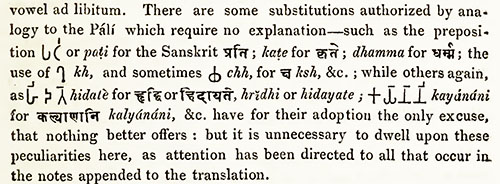
On searching the society's portfolio I found the five original manuscript plates of Captain Hoare, whence the engravings published in the Researches seem to have been copied. Their collation has been of essential service in detecting a few errors of the vowel marks that have crept into the engraving. I found also two much larger drawings of the first and last inscription of the series, apparently of the actual dimensions. — These I suppose to have been the originals presented to Sir William Jones by Colonel Polier, and therefore of themselves venerable for their antiquity! But they are by no means so faithful as Captain Hoare's copy, and the inscription round the column has the singular blunder of the two lowermost lines being copied in an inverted order, that is, written from right to left in the boustrophedon [from right to left and from left to right in alternate lines.] fashion. Nevertheless in one or two doubtful points they have rendered good service by supplying a vowel, or an anuswara required for the plural of a verb, omitted through mistake in the smaller copy.
In contriving a fount of type adapted to this ancient and highly elegant form of Nagari, I have made but a few insignificant alterations which I trust will not be thought unwarrantable. — The [x], [x] and [x], being of smaller size than the other letters in the original: — I have elongated them to square with the rest. The vowels also are in the original attached to the sides of these letters as [x]- ba, [x] thi, -[x] the; I have made them [x], [x], [x] to avoid an unseemly gap. The letter [x] is inflected on the centre with e and a thus [x], [x]; these I have for uniformity made [x], [x]: it is necessary to notice this, lest consulters of the originals should imagine I had been taking liberties with my materials. For the compound vowel o also I have been forced to content myself with a prolonged stroke (the e and a united) as [x] no, in lieu of the more elegant break given in the original to shew the two vowel marks as [x] no. Nothing material however is lost through these trifling modifications; while with them the ancient alphabet becomes easier to print, and certainly easier to read, than the more complicated letters of the (so-called) perfected (Samskrita) alphabet of the brahmans.
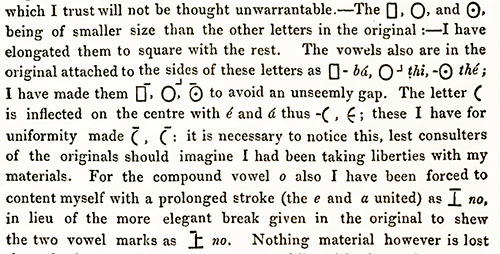
The four inscriptions facing the four cardinal points on the pillar, appear to be enclosed in frames and to be each complete in itself. These four edicts are repeated verbatim on the three other lats, with exception of the lower half of the eastern tablet which is wanting in all, as is likewise the long inscription round the shaft below the separate tablets.
On the other hand the Allahabad pillar has five short insulated lines at foot* [See plate IV. of Vol. III.] which are not to be found elsewhere. They are curious from their allusion three times to the second queen of Devanampiya; but from the incompleteness of the lines on the right hand the context cannot thoroughly be explained: the three letters at the end of the third line look like numerals.
Devanampiyasa vechanena savata vahamaga
Vataviya: eheta dutiyaya deviye dane.
Jambavadi kava alameva dana petha e (?)
Kichhi ganiyataye deviye senani ava.
Datiyaya deviye titivalamatu evakiye.
We might translate the whole of the first line: [x], By the word of Devanampiya — must be called a perfect ascetic or Brahmaga.' The second line certainly records a gift [x] 'of the second queen' — and the alamevadana, a sufficiency of gifts of some particular kind. Kichhi ganiyata dev may be supposed to be the name of the lady, or kichhi may be kinchit, some, little. — Senani, a general: — titi for tritiya third, and other insulated words can be recognized but without coherence.

To return from this digression: — The general object of Devanampiya's series of edicts is according to my reading, to proclaim his renunciation of his former faith, and his adoption of the Buddhist persuasion, to which wholesome change he invites others from every rank in society, by a representation of its great excellency. He addresses to his disciples, or devotees, (for so I have been obliged to translate rajaka, as the Sanskrit [x], though I would have preferred rajaka, ministers, had the first a been long — ) a number of specific rules for their guidance, with penalties of a comparatively mild nature for any omission in their performance: but the chief drift of the writing seems directed to enhance the merits of the author, — the continual recurrence of esa me kate, 'so have I done — arguing rather a vaunt of his own acts, than an inculcation of virtue in others, unless by the force of example.

It is a curious fact that although the intent of the royal convert seems to have been to spread every where the knowledge of his conversion, and of the virtuous acts to which it had given rise on his part, and further to set forth the main principles of his new faith, yet the name of the author of that religion is no where distinctly or directly introduced, as Buddha, Gotama, Shakya muni, &c. At the end of the first sentence, indeed, the expression Sukatam kachhati, which I have supposed to be intended for sugatam gachhati, may be thought to contain one of Buddha's names as Sugato, (the well-come) — but even in this the error in spelling makes the reading doubtful. In another place I have rendered a final expression agnim namisati, 'shall give praise to Agni' — a deity we are hardly at liberty to pronounce connected with the Buddhist worship, though points of agreement and harmony may be adduced. But in any case Agni if rendered generally as 'god' keeps him distinct from Buddha 'the teacher,' of whose deification no evidence is afforded by the inscription; for neither is there any allusion to images of him, nor to temples or shrines enclosing his relics. It is only by the general tenor of the dogmas inculcated, that we can pronounce it to relate to the Buddhist religion. The sacred name constantly employed — the true keystone of Shakya's reform — is Dhamma (or dharma), 'virtue;' upon the exceeding excellencies, and the incontestable supremacy, of which divine attribute the whole of his system seems to have originally rested, and by which it may have won its way to the hearts of a people whose inclinations were already imbued with admiration of this quality in their own ancient system, though it had since been mixed up with an unseemly mass of inconsistencies and gross idolatries: and the pious and reflecting must have been glad to reject them, when an opportunity was afforded of saving their consciences from the dreadful alternative of being thought to throw off all religion, if they discarded the one in which they were born and bred. Buddhism was at that time only sectarianism; a dissent from a vast proportion of the existing sophistry and metaphysics of the Brahmanical schools, without an absolute relinquishment of belief in their gods, or of conformity in their usages, and with adherence still to the milder qualities of the religion, to all in short that it contained of dharma, — virtue, justice, law. The very term Devanampiya, 'beloved of the gods,' shews the retention of the Hindu pantheon generally; and this might be easily confirmed by reference to Mr. Csoma's note on the birth and life of Shakya.
The conquest by Darius introduced the Persians' new religion, reformed Mazdaism, or Early Zoroastrianism, a strongly monotheistic faith with a creator God, Ahura Mazda, and with ideas of absolute Truth (Avestan asa, Old Persian arta) versus 'the Lie' (druj), and of an accumulation of Good and Bad deeds -- that is, "karma" -- which determined whether a person would be rewarded by "rebirth" in Heaven. These ideas are all found in the Gathas, the oldest part of the Avesta, which are attributed to Zoroaster himself, and all are expressed openly and repeatedly in the Old Persian royal inscriptions as well. Essentially the same ideas occur in the Major Inscriptions of the Mauryas in the third century BC in India. The traditional view is that the Buddha reinterpreted existing Indian ideas found in the Upanishads, but the Upanishads in question cannot be dated to a period earlier than the Buddha, as shown by Bronkhorst and discussed below. Just as Early Buddhism cannot be expected to be similar to the Normative Buddhism of a half millennium or more later, so Early Brahmanism cannot be expected to be similar to Late Brahmanism (not to speak of Hinduism), attested even later. "Zoroaster was ... the first to teach the doctrines of ... Heaven and Hell, the future resurrection of the body ... , and life everlasting for the reunited soul and body", and Early Zoroastrianism was the faith of the ruling nation of the Persian Empire. Both Early Buddhism and Early Brahmanism are the direct outcome of the introduction of Zoroastrianism into eastern Gandhara by Darius I. Early Buddhism resulted from the Buddha's rejection of the basic principles of Early Zoroastrianism, while Early Brahmanism represents the acceptance of those principles. Over time, Buddhism would accept more and more of the rejected principles. Darius also sponsored the creation of a completely new writing system -- Old Persian cuneiform script, which is partly modeled on Aramaic script, one of the main administrative scripts of the Persian Empire -- and the practice of erecting monumental inscriptions.
-- Greek Buddha: Pyrrho's Encounter With Early Buddhism in Central Asia, by Christopher I. Beckwith
Those who have studied the mystics of Buddhism from the lucid dissertation of Mr. Hodgson in the January and February Nos. of last year's Journal [(Jan.) II.—Quotations from original Sanscrit authorities in proof and illustration of Mr. Hodgson's sketch of Buddhism (p. 28); (Feb.) II.—Quotations from Original Sanscrit Authorities in proof and illustration of Mr. Hodgson's Sketch of Buddhism (p. 71)], will know that Dharma is the second member of the Triamnaya, or triad, — (Buddha, Dharma, Sangha, — ) according to the theistical school; while what Mr. Hodgson calls the atheistical school exalts Dharma to the first place. With them "Dharma is Diva natura, matter as the sole entity, invested with intrinsic activity and intelligence, the efficient and material cause of all: — Buddha is derivative from Dharma, is the active and intelligent force of nature first put off from it and then operating upon it:—Sangha is the result of that operation; is embryotic creation, the type and sum of all specific forms, which are spontaneously evolved from the union of Buddha with Dharma*." [Journ. As. Soc. Vol. V. page 37.] Happily in our inscription there is no necessity to resort to these subtleties of the schools which have rendered a plain matter perplexed. The word is here evidently used in its simple sense of "the law, virtue, or religion" — and though its gifts and excellencies are vaunted, there is no worship offered to it, no godhead claimed for it.
The word dhamma is in the document before us generally coupled with another word, vadhi, in its several cases, dhamma-vadhi, dhamma-vadhiya, &c. according to the Sanskrit grammatical rules of combination or samasa.
The most obvious interpretation of the word vadhi is found in the Sanskrit [x] vriddhi, increase, whence are derived the vernacular words barhna, to increase; barhta, increasing; barhai, increase, &c., differing imperceptibly in pronunciation from the vadhi and vadhita of the inscription. The constant recurrence of the same expression would lead to the conclusion that the religion of Buddha was then generally known by this compound title, as 'the increase of virtue,' 'the expansion of the law,' in allusion to the rapid proselytism which it sought and obtained.

While, not surprisingly, the ordinary generic human contrast between truth and falsehood is found in the Vedas, the specifically Early Zoroastrian form of the ideas, including the result of following one or the other path, is completely alien to them. In the early Vedic religion, ritually correct performance of blood sacrifices was believed to be rewarded in this life, but the reward had nothing to do with one's virtuous actions or one's future in the afterlife. These ideas thus seem to have been introduced by the Achaemenid Persians into eastern Gandhara and Sindh, the western limits of the ancient Indic world and southeastern limits of the Central Asian world, just as they were introduced into Near Eastern parts of the vast Persian Empire. In fact, Early Zoroastrianism is attested in Achaemenid Central Asia and India in the earliest Persian imperial written documents from the region.
-- Greek Buddha: Pyrrho's Encounter With Early Buddhism in Central Asia, by Christopher I. Beckwith
Against this interpretation if it be urged that the dental dh [x] is in other cases used for the Sanskrit dh [x]; as in the word dharmma itself; in vadha, murder; bandha, bound, &c. Such objection may be met by instancing other undoubted cases where the cerebral dh is used for the Sanskrit [x] ddh as in [x] adhakosayani (for arddha) 'half kos;' and in like manner the dental rth is generally expressed by the cerebral th, as atha, athaya for [x], [x].
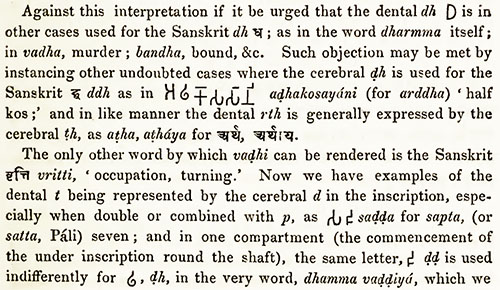
The only other word by which vadhi can be rendered is the Sanskrit [x] vritti, 'occupation, turning.' Now we have examples of the dental t being represented by the cerebral d in the inscription, especially when double or combined with p, as [x] sadda for sapta, (or satta, Pali) seven; and in one compartment (the commencement of the under inscription round the shaft), the same letter, [x] is used indifferently for [x], dh, in the very word, dhamma vadaiya, which we are discussing. It is hardly possible to imagine that two expressions so strikingly similar in orthography as dhammavadhi and dhammavatti or vadai, yet of such opposite meaning should be applied to the same thing. One must be wrong; and I should have had no question which to prefer, were it not for a curious expression I remembered to have met with in the Tibetan translation of the Buddhist volumes. Of the twelve principal acts in Shakya's life described in the Gyacherrolpa (S. Lalitavistara), the tenth is translated by Mr. Csoma Korosi, "He turns the wheel of the law, or publishes his doctrine;" now it was possible that the Sanskrit of this expression might be found [x] or in the Pali, dhammavutti vavethayati, vutti signifying explication or doctrine, as well as 'wheel.'

Finding a copy of the Lalita Vistara in Sanskrit amongst Mr. Hodgson's valuable collection of Buddhist works transferred from the College of Fort William to the Asiatic Society's library, I requested my pandit Kamalakanta to look into it for this expression 'wheel of the law' adopted by the Tibetan translators; and he was not long in extracting an abundance of examples of its use: thus in the 299th leaf, in the 25th adhyaya, Tathagata (Buddha) is made to say: —

[x]
'I will go to Benares: — having arrived at the city of Kashi, I will turn the wheel of the law, which is revolving amongst mankind, (i.e. I will run my religious course.')
The word dharmachakra is here distinct enough, and not to be confounded with our dhammavadhi. The following example from the 213th leaf, I therefore add less to strengthen the evidence than as a curious employment of many of the expressions met with in other parts of our inscription, particularly in the eastern tablet.

[x]
"Having bowed the head in reverence: — Do thou, oh Bhagavan, be pleased to set about turning the wheel of the law of him that hath firmly embraced Tathagata. Turn thou the wheel of the law oh Sugata! For the benefit of much people, for the delight of much people, for compassion to the world, for the urgent reason of the necessities of man, — for the benefit, for the delight alike of angels and men, — perform thou, oh Bhagavan, the sacrifice of the law: — pour down the plentiful shower of the law: — lift up on high the great banner of the law: — blow forth the great conch of the law: —strike loud the great drum of the law!"

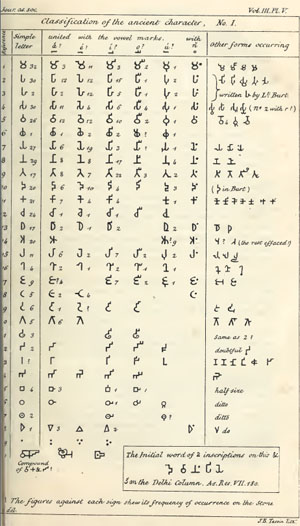

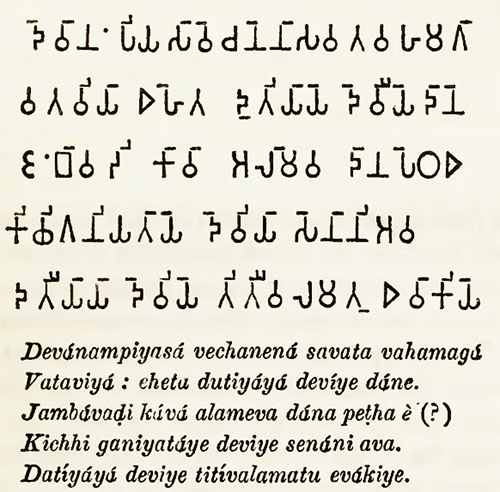



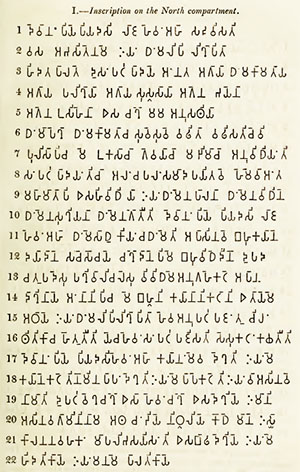
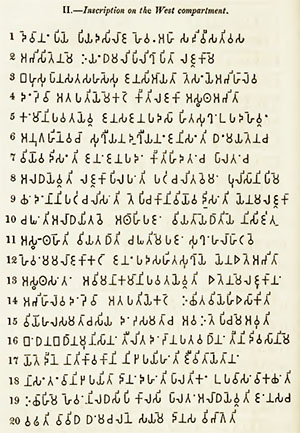
 the rest as here given.]
the rest as here given.] 